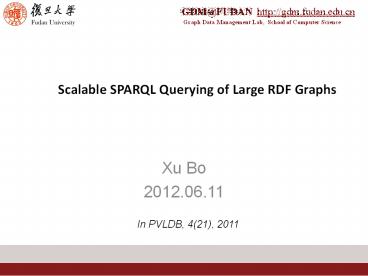Scalable SPARQL Querying of Large RDF Graphs - PowerPoint PPT Presentation
1 / 42
Title:
Scalable SPARQL Querying of Large RDF Graphs
Description:
Title: 1 Author: Leon Description: TR Template of SOARingLab Last modified by: Jxulie Created Date: 10/5/2005 1:11:43 AM Document presentation format – PowerPoint PPT presentation
Number of Views:205
Avg rating:3.0/5.0
Title: Scalable SPARQL Querying of Large RDF Graphs
1
Scalable SPARQL Querying of Large RDF Graphs
- Xu Bo
- 2012.06.11
In PVLDB, 4(21), 2011
2
Outline
- About Presenter
- Semantic Web
- Previous Work
- New Problem
- SYSTEM ARCHITECTURE
- EXPERIMENTS
- CONCLUSIONS AND FUTURE WORK
3
About Presenter
- Daniel Abadi
- Associate Professor of Computer
- Science in Yale University
- Research
- Column-Oriented Database Systems
- Petascale Parallel Database Systems (HadoopDB)
- Semantic Web Data Management
4
Semantic Web
- The vision of Semantic Web is to build a "web of
data" that enables machines to understand the
semantics of information on the Web
5
Google Knowledge Graph
6
Key Technology
- HTML
- XML
7
The Disadvantage of XML
- David Billington is a lecturer of Discrete
Mathematics. - there is no standard way of assigning meaning to
tag nesting
8
The Disadvantage of Xpath
- Suppose we want to collect all academic staff
members. A path expression in Xpath might be
//academicStaffMember - XML is semantically unsatisfactory
9
RDF
- Resource Description Framework
- ?Web???(?????????,Uniform Resource
Identifiers?URIs)?????,??????(property)?????????
10
RDF as Triples and a Graph
11
SPARQL
- RDF query language
- A basic graph pattern
- Answering SPARQL can be seen as finding subgraphs
in the RDF data that match the graph pattern
12
Example for Star Pattern
- Find the names of the strikers that play for FC
Barcelona.
13
Another Example
- Find football players playing for clubs in a
- populous region where they were born.
14
(No Transcript)
15
Previous Work
- RDF In RDBMSs
- Property Tables
- Vertically Partitioned Approach
16
RDF In RDBMSs
- Get the title of the book(s) Joe Fox wrote in 2001
17
Property Tables
18
Vertically Partitioned Approach
19
New Problem
- Single node RDF management systems are abundant
- Sesame
- Jena
- RDF3X
- 3store
- Research in clustered RDF management is less
significantly explored The focus of the talk
20
SYSTEM ARCHITECTURE
21
Graph Partitioning
- Hash vs. Graph partitioning
- Hash Only efficient for star patterns
- Graph Taking advantage of graph model
22
Graph Partitioning
- Edge vs. Vertex partitioning
- Edge Natural but inefficient for query execution
- Vertex Superior for common graph patterns
23
Vertex Partitioning
- Preprocess
- remove triples whose predicate is rdftype
- METIS partitioner
24
Triple Placement
- Minimizing data shuffling/exchange
- Allowing data overlap
- N-hop guarantee
- The extent of data overlap
- If a vertex is assigned to a machine, any vertex
that is within n-hop of this vertex is also
stored in this machine
25
DIRECTED N-HOP GUARANTEE
26
A potential problem
- triples (s, p, o) and (o, p, o)
- 2-hop guarantee
- triples (s, p, o) and (s, p, o)
- not guaranteed
- object-connected is not unusual
- undirected n-hop guarantee
27
Triple Placement Algorithm
28
Query Processing
- Queries are executed in RDF-stores and/or Hadoop
- Query execution is more efficient in RDF-stores
than in Hadoop - Pushing as much of the processing as possible
into RDF-stores - Minimizing the number of Hadoop jobs
- The larger the hop guarantee, the more work is
done in RDF-stores
29
To Communicate, or not to Communicate
- Given a query and n-hop guarantee, is
communication (Hadoop job) between nodes needed? - Choose the center of the query graph
- Calculate the distance from the center to the
furthest edge - If distance gt n, communication is needed not
needed otherwise
30
Determining whether a Query is PWOC
- PWOC Query
- parallelizable without communication
- DoFE
- distance of farthest edge
- the vertex in a graph with the smallest DoFE will
be the most central in a graph
31
The algorithm
32
the issue of duplicate results
- naive approach
- remove duplicates after the query has completed
- owner-computes model
- add triples (v, ltisOwnedgt, Yes) to a
partition - For each query issued to the RDF-stores, add an
additional pattern (core, ltisOwnedgt, Yes)
33
A query is not PWOC
- decompose the query into PWOC subqueries
- use Hadoop jobs to join the results of the PWOC
subqueries - The number of Hadoop jobs required to complete
the query increases as the number of subqueries
increases
34
minimal number of subqueries
- reduces to the problem of finding minimal edge
partitioning of a graph into subgraphs of bounded
diameter - brute-force
35
Examlple
DoFEs for manager, footballClub, Barcelona and
club are 2, 2, 2 and 1
the DoFEs for footballer, pop, region, player and
club are 3, 3, 2, 2 and 2,
36
Decompose Example
37
EXPERIMENTS
- 20-machine cluster
- Leigh University Benchmark (LUBM) 270 million
triples - Competitors
- Single-node RDF-3X
- SHARD triple-store system in Hadoop
- Graph partitioning (the proposed system)
- Hash partitioning on subjects
38
Data Load Time
39
Performance Comparison
40
Varying Number of Machines
41
Summary
42
Thanks !































